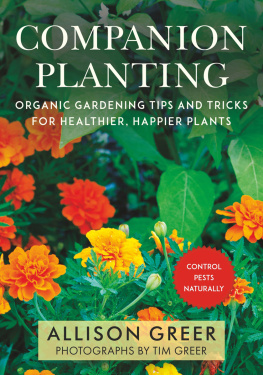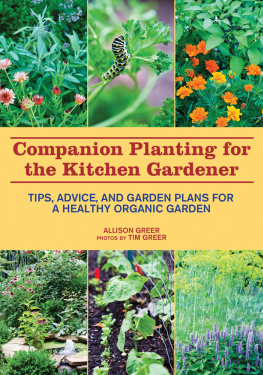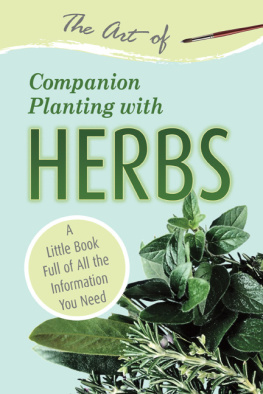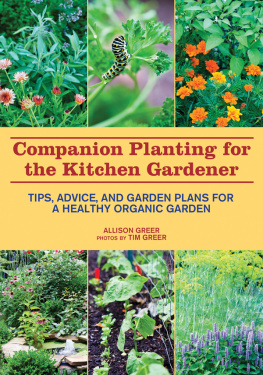The Art of
Companion Planting with Fruits
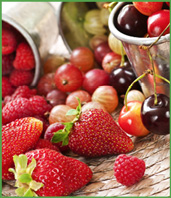
A Little Book Full of All the Information You Need
The Art of Companion Planting with Fruits: A Little Book Full of All the Information You Need
Copyright 2012 Atlantic Publishing Group, Inc.
1210 SW 23rd Place Ocala, Florida 34471
Phone 800-814-1132 Fax 352-622-1875
Web site:
SAN Number: 268-1250
No part of this publication may be reproduced, stored in a retrieval system, or transmitted in any form or by any means, electronic, mechanical, photocopying, recording, scanning, or otherwise, except as permitted under Section 107 or 108 of the 1976 United States Copyright Act, without the prior written permission of the Publisher. Requests to the Publisher for permission should be sent to Atlantic Publishing Group, Inc., 1210 SW 23rd Place, Ocala, Florida 34471.
All trademarks, trade names, or logos mentioned or used are the property of their respective owners and are used only to directly describe the products being provided. Every effort has been made to properly capitalize, punctuate, identify and attribute trademarks and trade names to their respective owners, including the use of and wherever possible and practical. Atlantic Publishing Group, Inc. is not a partner, affiliate, or licensee with the holders of said trademarks.
LIMIT OF LIABILITY/DISCLAIMER OF WARRANTY: The publisher and the author make no representations or warranties with respect to the accuracy or completeness of the contents of this work and specifically disclaim all warranties, including without limitation warranties of fitness for a particular purpose. No warranty may be created or extended by sales or promotional materials. The advice and strategies contained herein may not be suitable for every situation. This work is sold with the understanding that the publisher is not engaged in rendering legal, accounting, or other professional services. If professional assistance is required, the services of a competent professional should be sought. Neither the publisher nor the author shall be liable for damages arising herefrom. The fact that an organization or Web site is referred to in this work as a citation and/or a potential source of further information does not mean that the author or the publisher endorses the information the organization or Web site may provide or recommendations it may make. Further, readers should be aware that Internet Web sites listed in this work may have changed or disappeared between when this work was written and when it is read.

A few years back we lost our beloved pet dog Bear, who was not only our best and dearest friend but also the Vice President of Sunshine here at Atlantic Publishing. He did not receive a salary but worked tirelessly 24 hours a day to please his parents.
Bear was a rescue dog who turned around and showered myself, my wife, Sherri, his grandparents Jean, Bob, and Nancy, and every person and animal he met (well, maybe not rabbits) with friendship and love. He made a lot of people smile every day.
We wanted you to know a portion of the profits of this book will be donated in Bears memory to local animal shelters, parks, conservation organizations, and other individuals and nonprofit organizations in need of assistance.
Douglas & Sherri Brown
PS: We have since adopted two more rescue dogs: first Scout, and the following year, Ginger. They were both mixed golden retrievers who needed a home.
Want to help animals and the world? Here are a dozen easy suggestions you and your family can implement today:
- Adopt and rescue a pet from a local shelter.
- Support local and no-kill animal shelters.
- Plant a tree to honor someone you love.
- Be a developer put up some birdhouses.
- Buy live, potted Christmas trees and replant them.
- Make sure you spend time with your animals each day.
- Save natural resources by recycling and buying recycled products.
- Drink tap water, or filter your own water at home.
- Whenever possible, limit your use of or do not use pesticides.
- If you eat seafood, make sustainable choices.
- Support your local farmers market.
- Get outside. Visit a park, volunteer, walk your dog, or ride your bike.
Five years ago, Atlantic Publishing signed the Green Press Initiative. These guidelines promote environmentally friendly practices, such as using recycled stock and vegetable-based inks, avoiding waste, choosing energy-efficient resources, and promoting a no-pulping policy. We now use 100-percent recycled stock on all our books. The results: in one year, switching to post-consumer recycled stock saved 24 mature trees, 5,000 gallons of water, the equivalent of the total energy used for one home in a year, and the equivalent of the greenhouse gases from one car driven for a year.
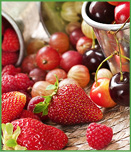
INTRODUCTION: Overview on Companion Planting
C ompanion planting is a phrase that has taken on many meanings for todays gardeners. Within the scientific community, companion planting is also called intercropping and is a form of polyculture , which describes a method of planting species of plants together for mutual benefit, usually in agricultural situations.
For the layman, companion planting is best described as the practice of planting two or more plants together to enhance the growth and quality of nearby plants; to provide maximum ground cover; and, when possible, to improve the soil. This approach to gardening offers many benefits, with the trade-off being that more thought needs to go into the garden planning stage when deciding which plants should go where. Although there is no scientific explanation as to how or why the plants benefit one another, when planted in companionable ways, much has been learned over the years with a great deal of success.
Some of the successful companion planting relationships are due to the release of chemical secretions at the roots, which may affect other plants or have an effect on organisms in the soil. It has been theorized that companion planting benefits may result from the plant releasing certain gases or odors that can repel pests from either the roots or the above-ground parts of the plant. With certain predators (notably insects that damage the plants) out of the way, the plants can flourish. The same goes for other potential pairings. One plant may have the ability to do something like provide structure, add nitrogen to the soil, or offer shade in such a way that makes another plant flourish without hurting itself.
There have been lab studies where scientists have tried to replicate the results of companion planting with mixed results. By adding the juices of pairs of plants to a 5 percent copper chloride solution and allowing it to crystallize slowly on a glass plate, Dr. Ehrenfried E. Pfeiffer and Dr. Erica Sabarth of the Bio-Dynamic Association were able to predict which plants would be companions and which would be antagonistic from the resulting crystallization patterns. Their findings, along with the trial and error of numerous gardeners, were summarized in a pamphlet by Richard Gregg in 1943 called Companion Plants and How to Use Them. Today, similar studies use paper chromatography techniques for related tests.
The companion fruit suggestions in this book should be used as a basis for your own experimentation, not as a proven guide to success. One of the most important considerations when you look at choosing your own companion fruits is to not lock yourself in by this books information. Try some of the combinations out for yourself, experiment with new ones, but also play around with the spacing between the plants and the ratio of one plant to another.



